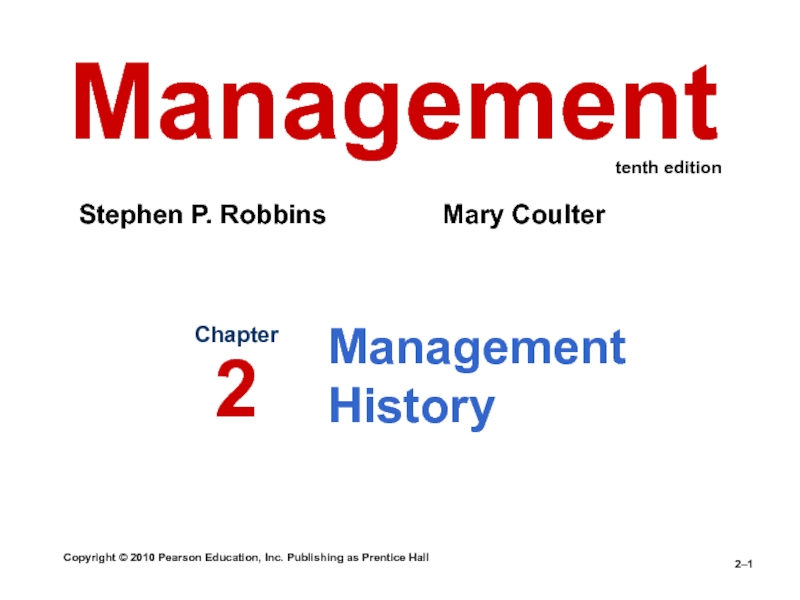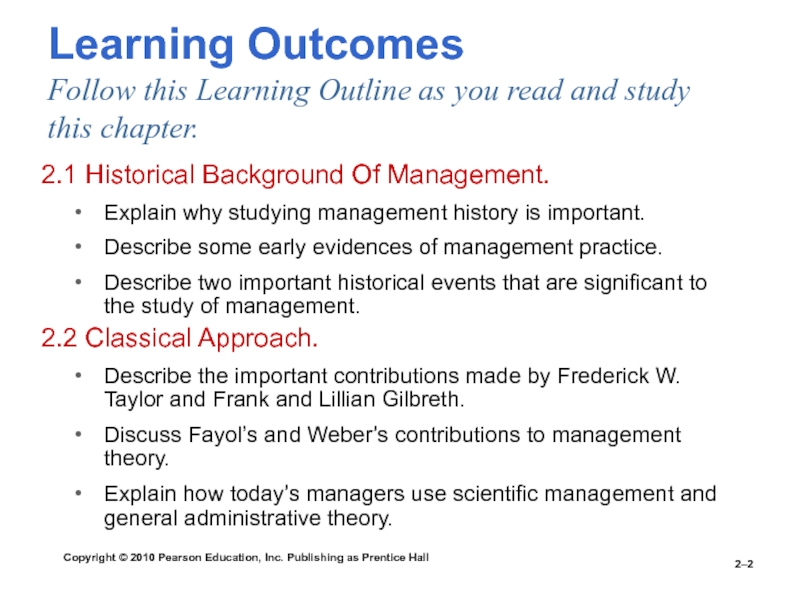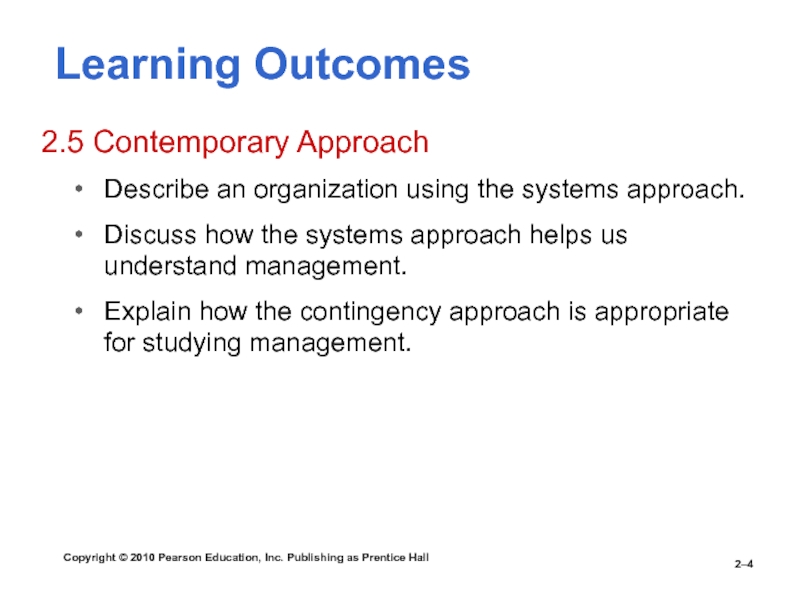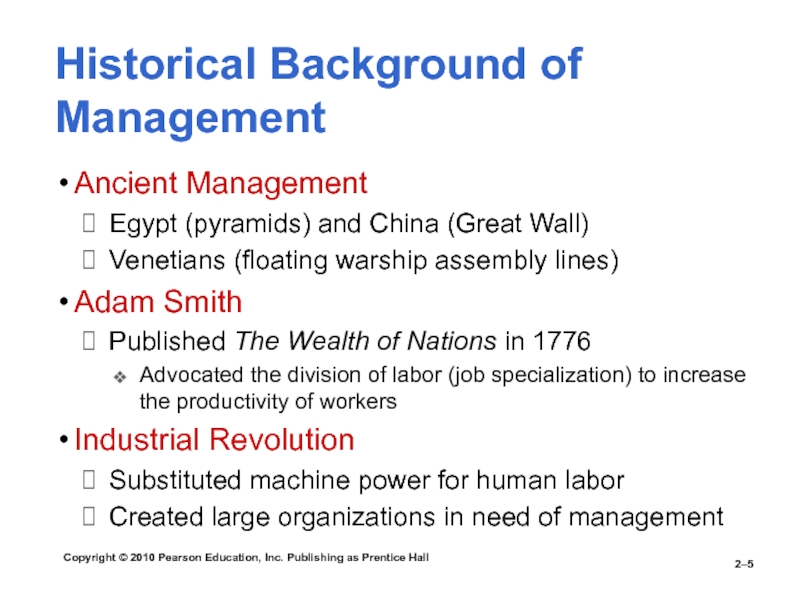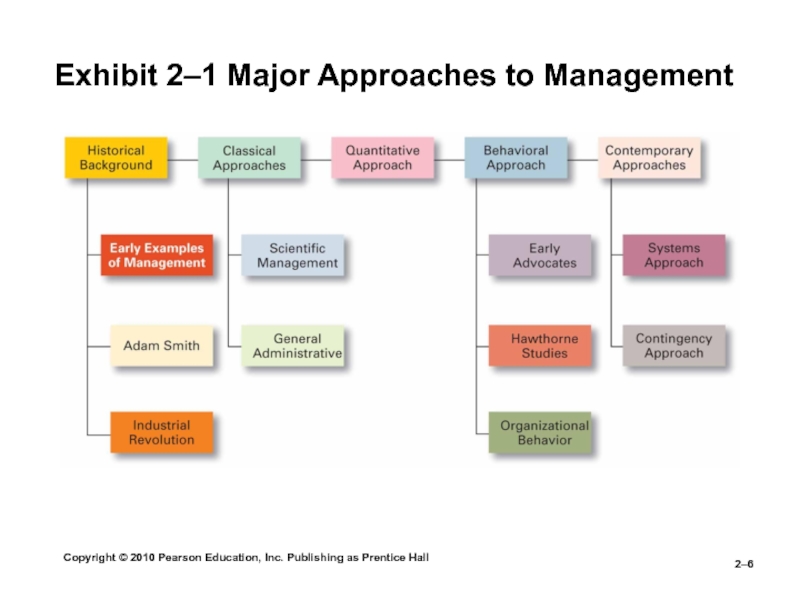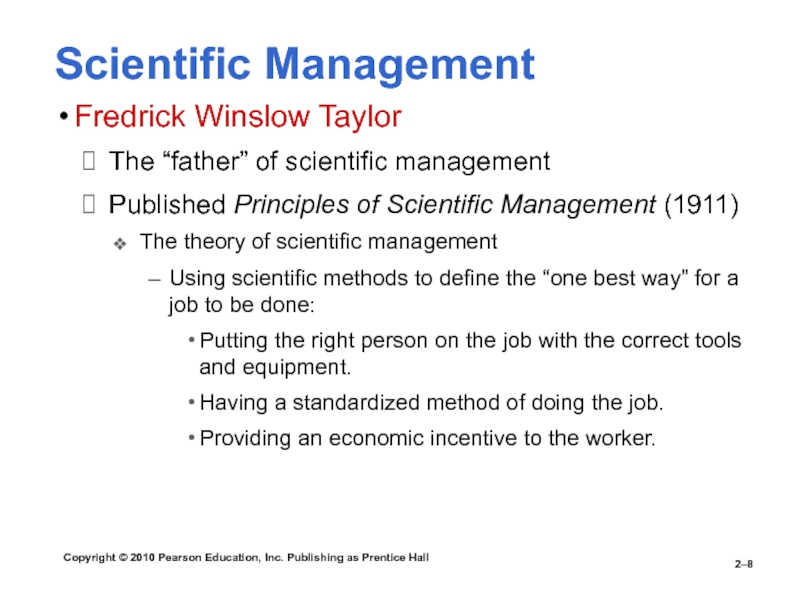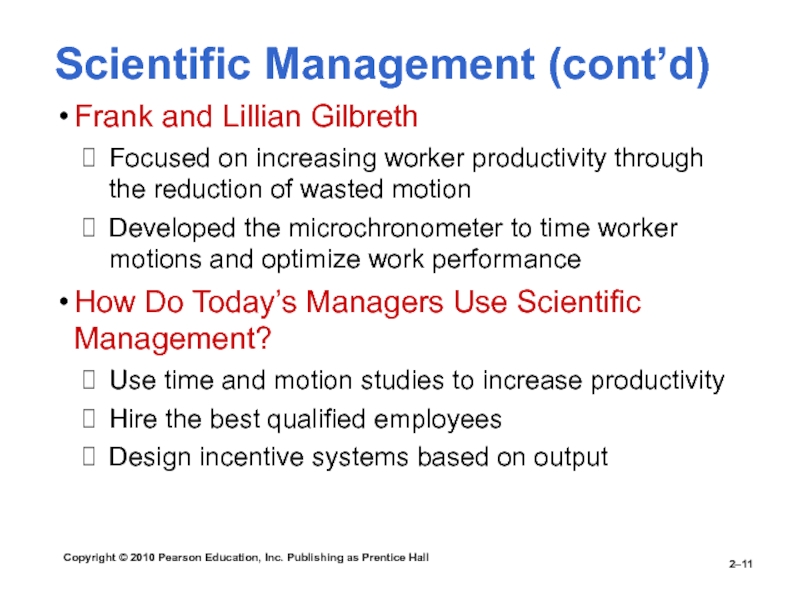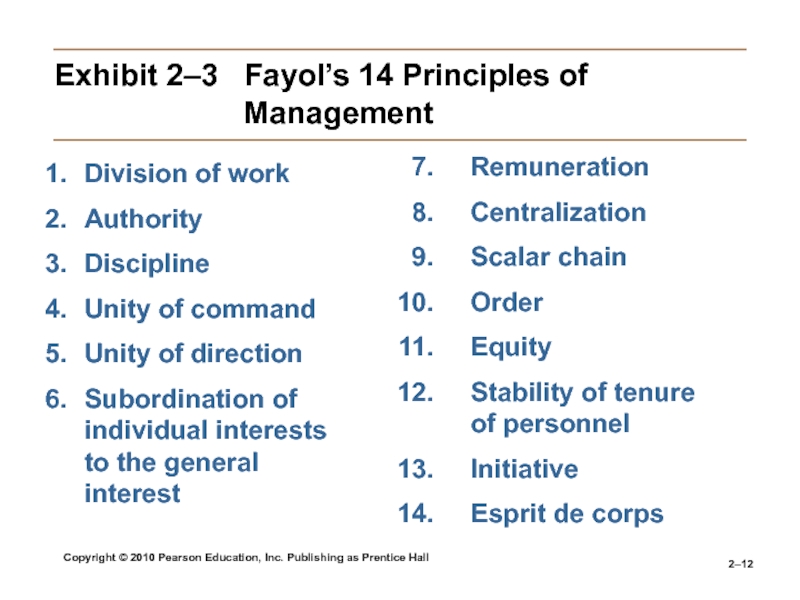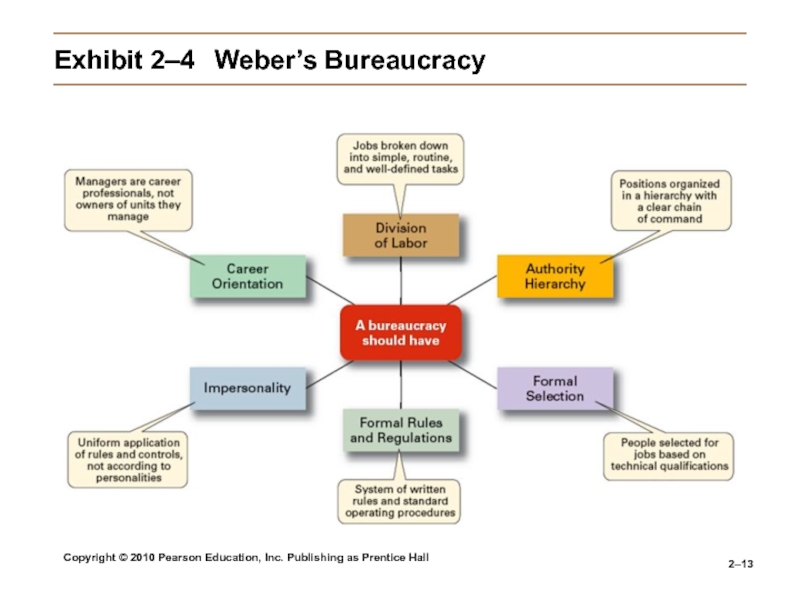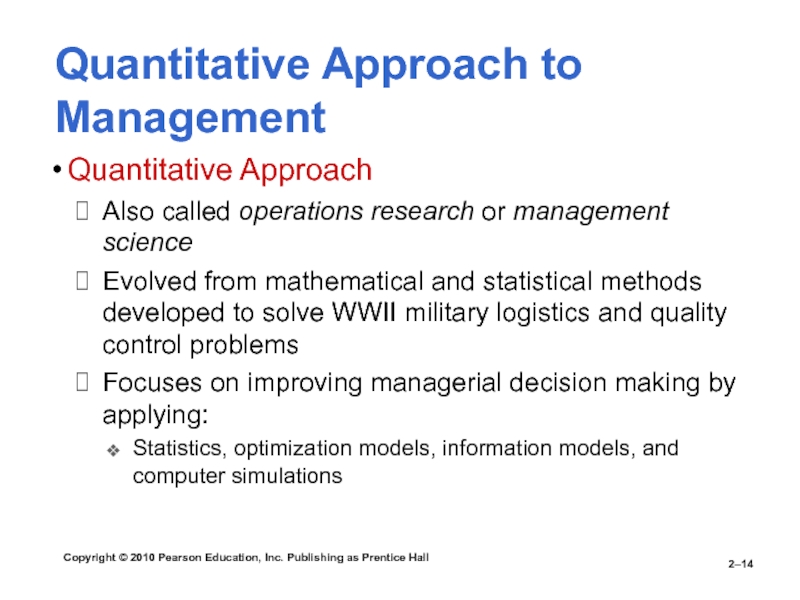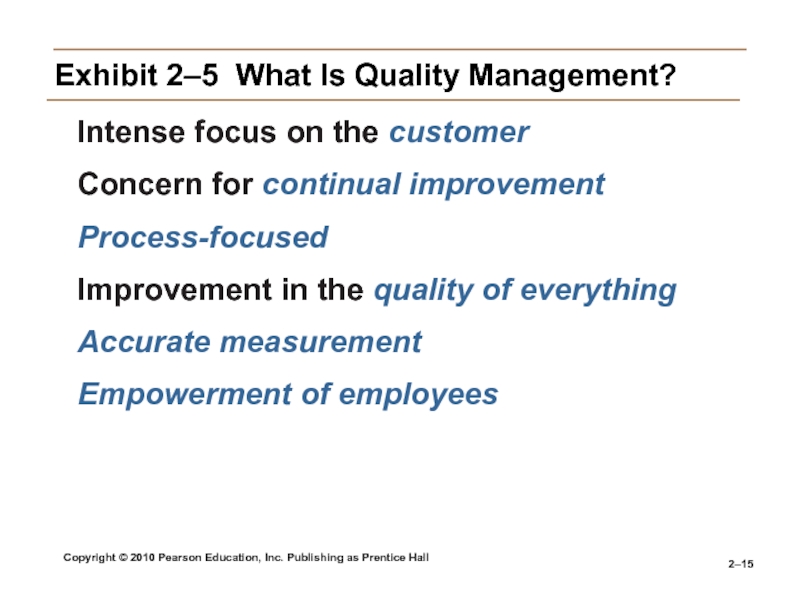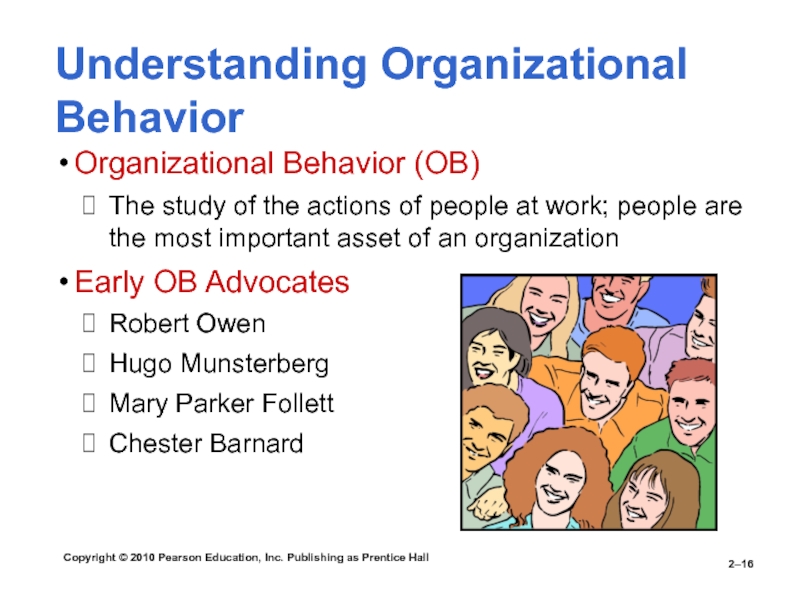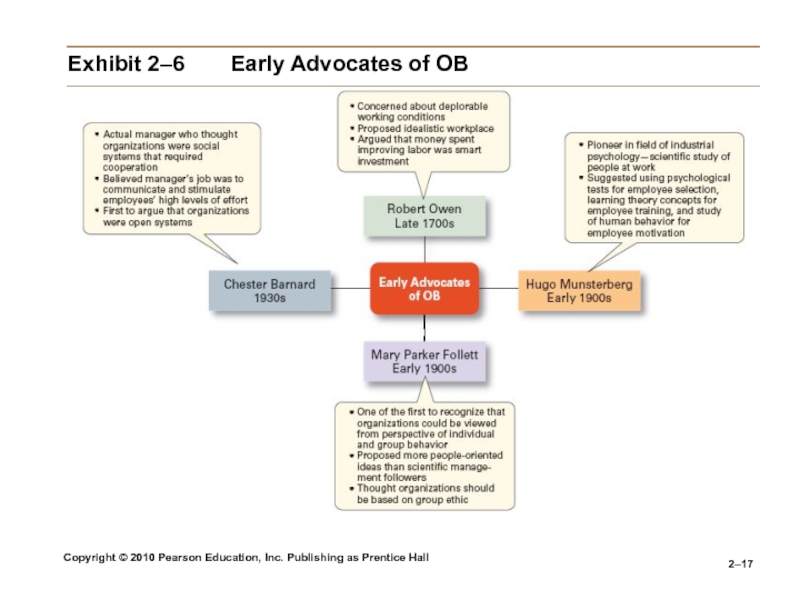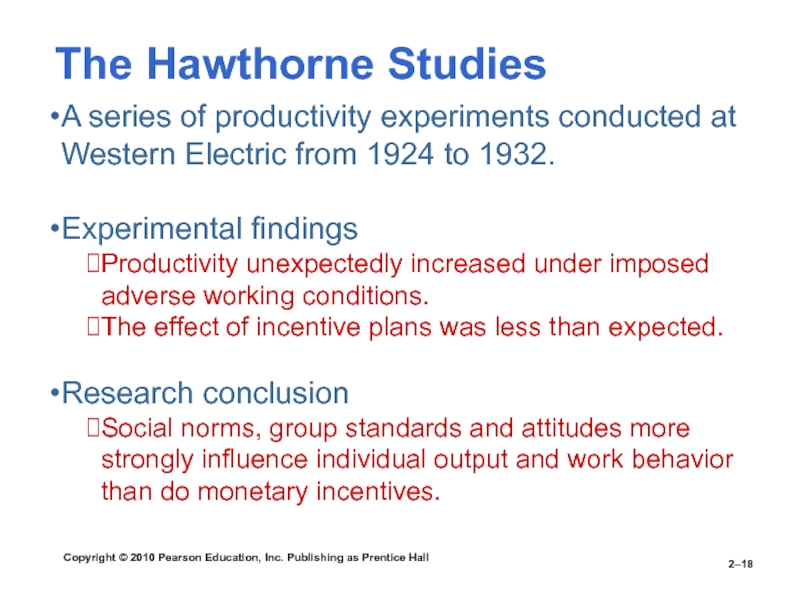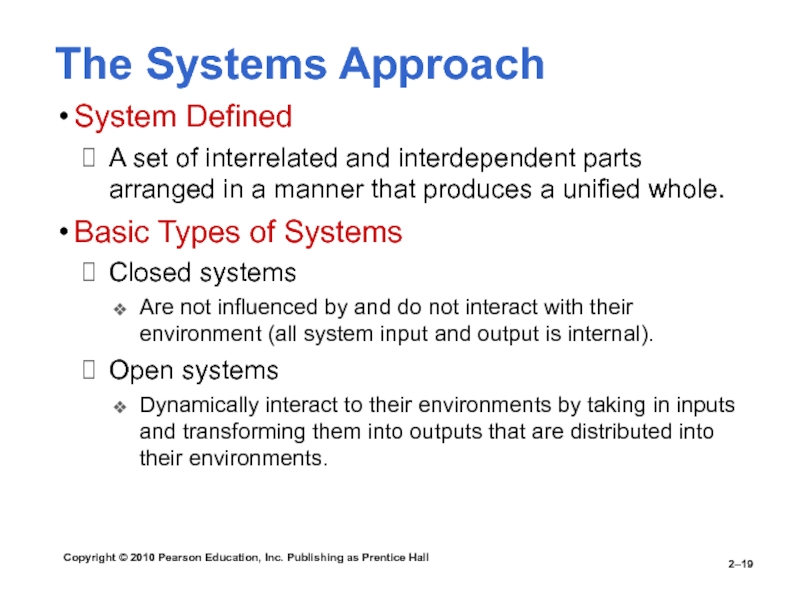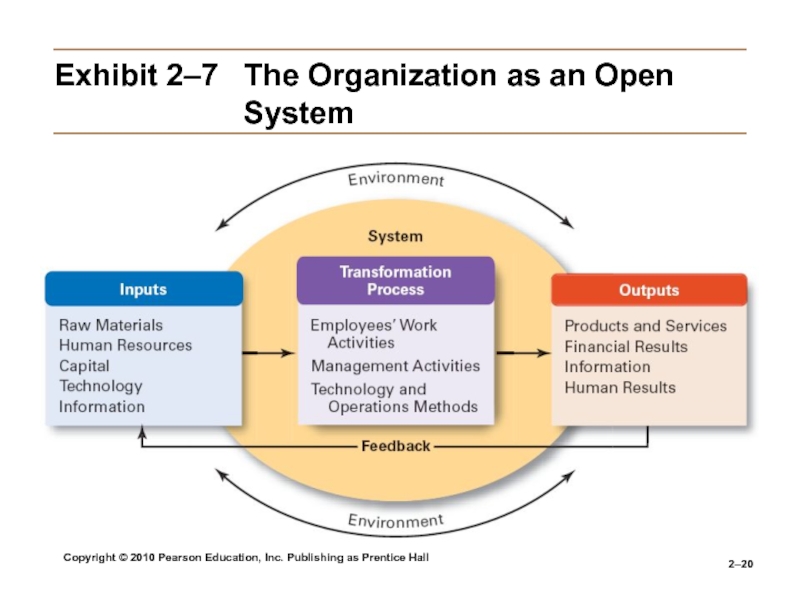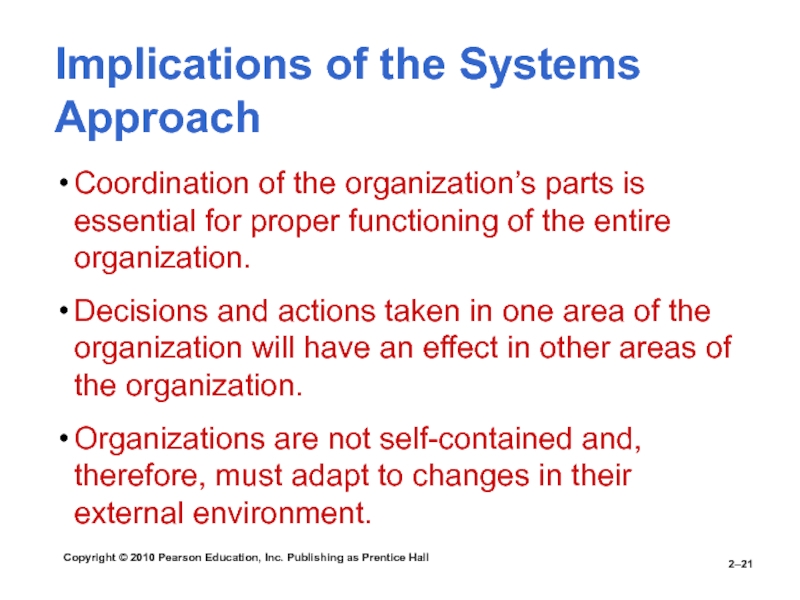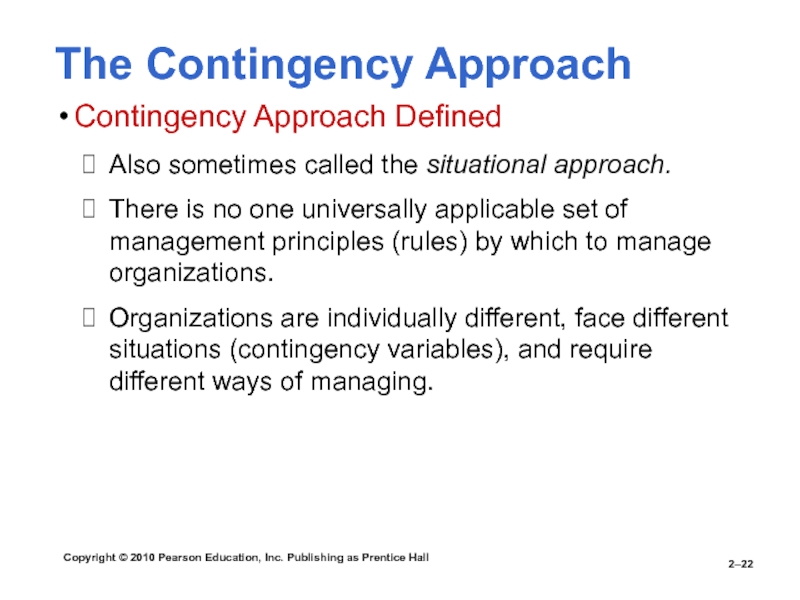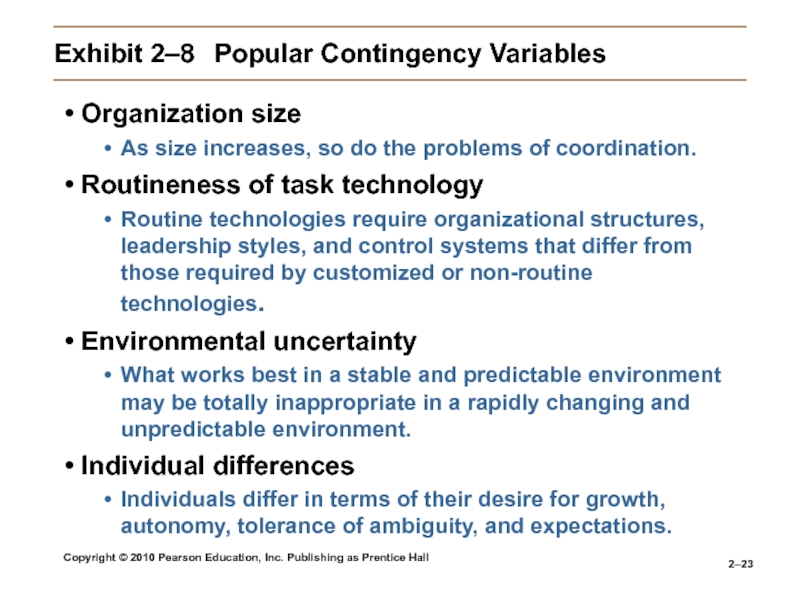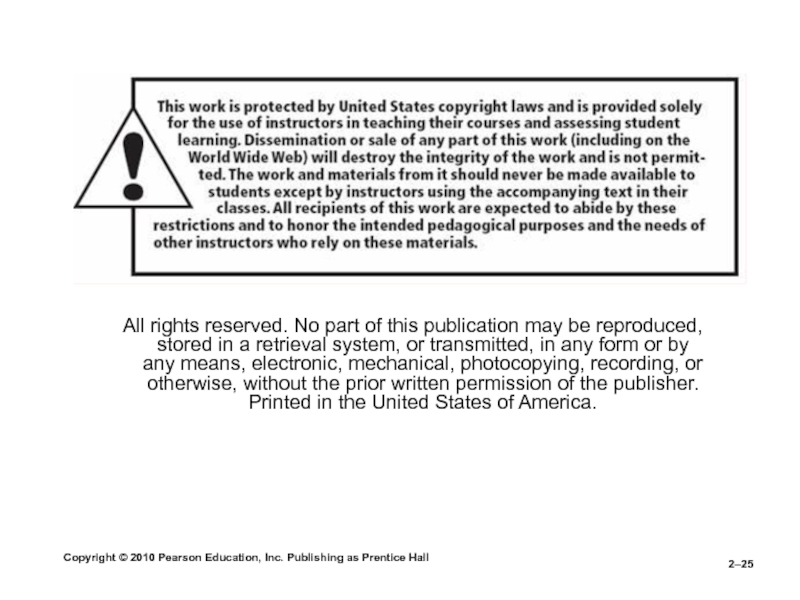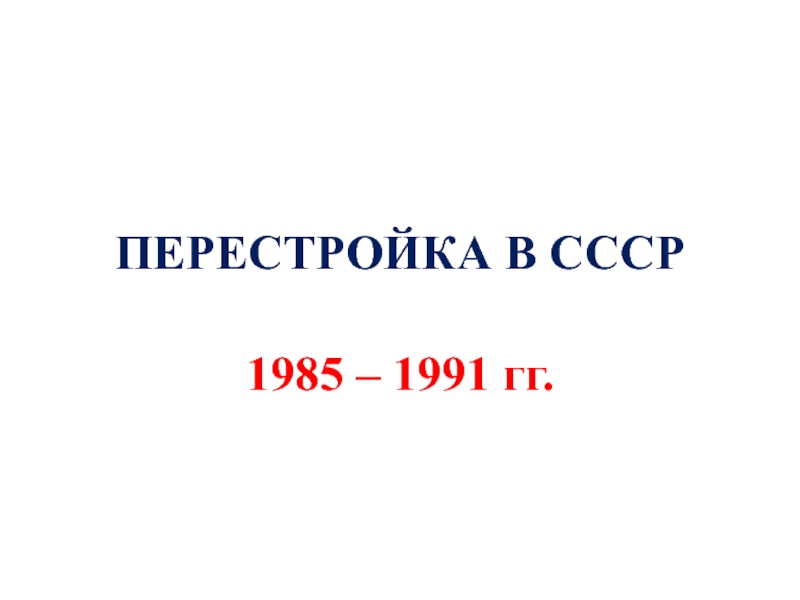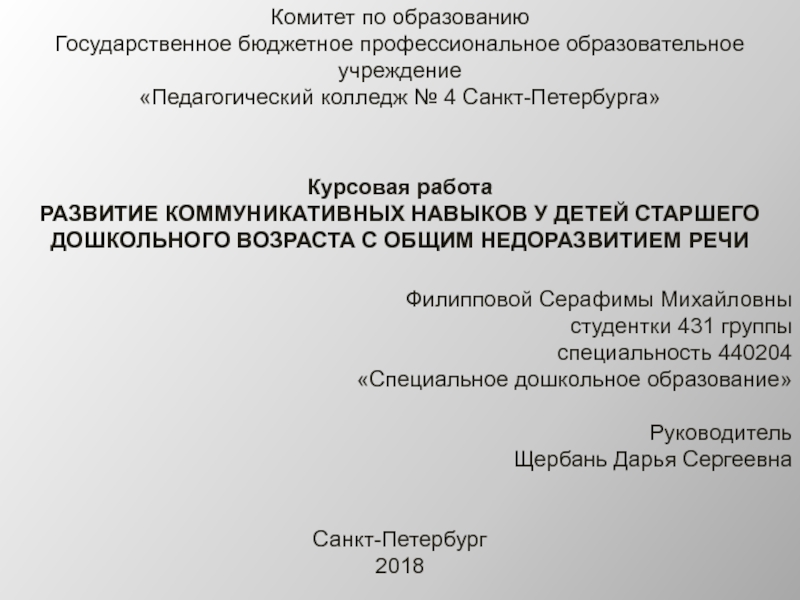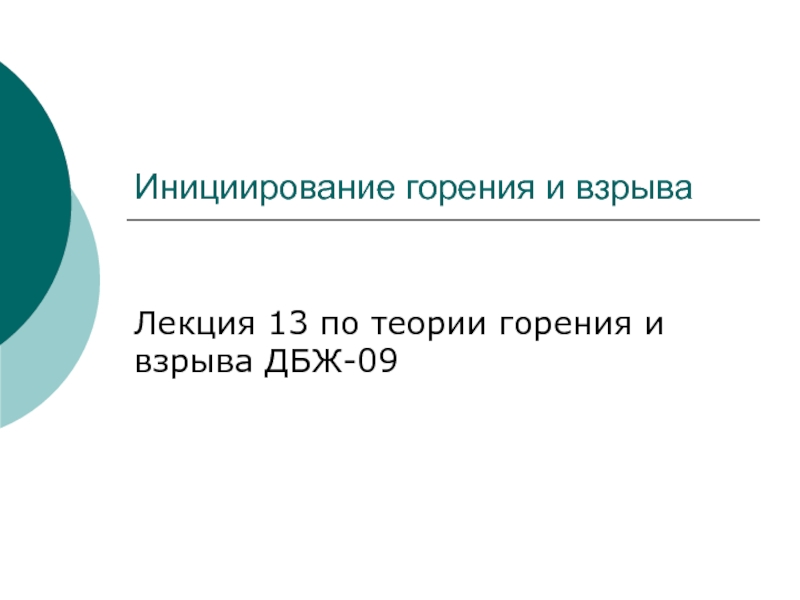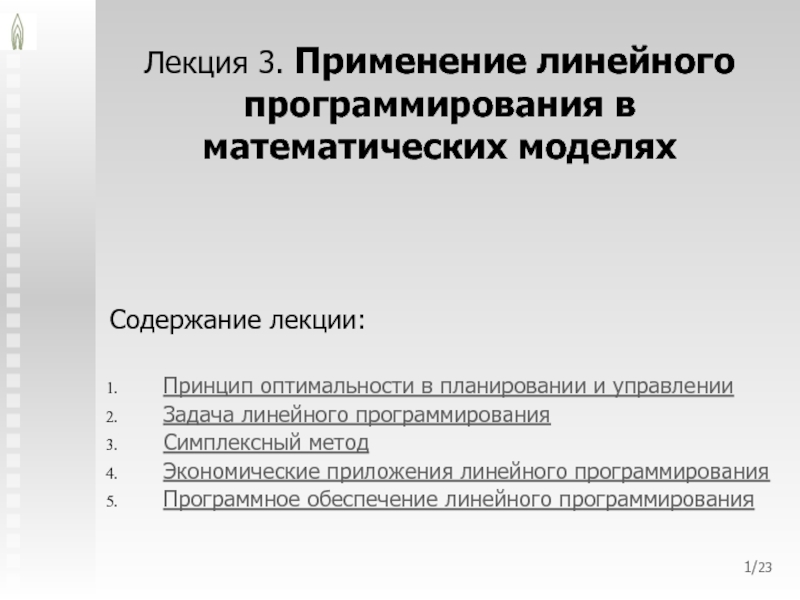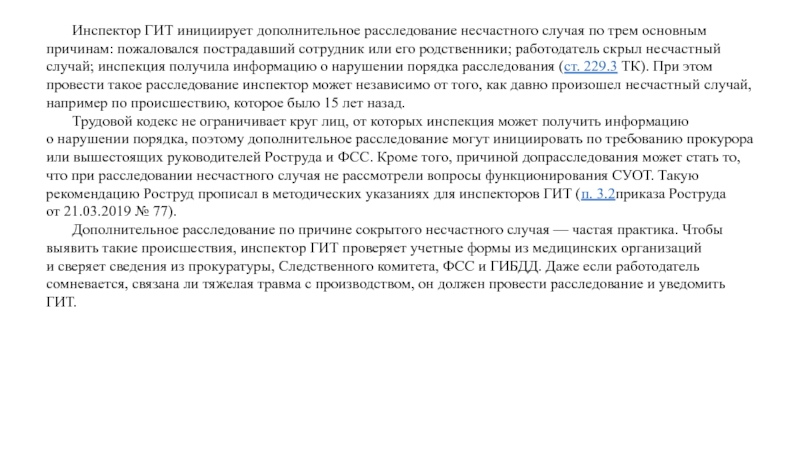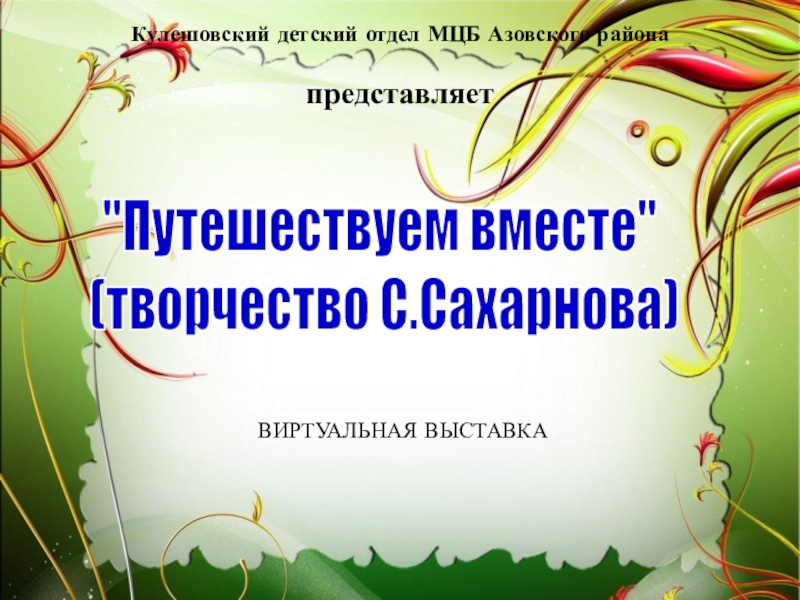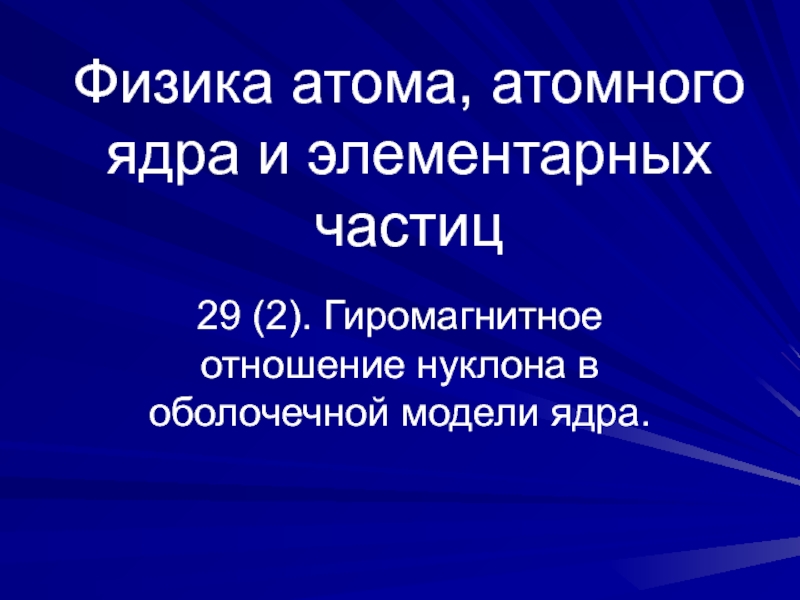Разделы презентаций
- Разное
- Английский язык
- Астрономия
- Алгебра
- Биология
- География
- Геометрия
- Детские презентации
- Информатика
- История
- Литература
- Математика
- Медицина
- Менеджмент
- Музыка
- МХК
- Немецкий язык
- ОБЖ
- Обществознание
- Окружающий мир
- Педагогика
- Русский язык
- Технология
- Физика
- Философия
- Химия
- Шаблоны, картинки для презентаций
- Экология
- Экономика
- Юриспруденция
Management History
Содержание
- 1. Management History
- 2. Copyright © 2010 Pearson Education, Inc. Publishing
- 3. Copyright © 2010 Pearson Education, Inc. Publishing
- 4. Copyright © 2010 Pearson Education, Inc. Publishing
- 5. Copyright © 2010 Pearson Education, Inc. Publishing
- 6. Copyright © 2010 Pearson Education, Inc. Publishing as Prentice Hall2–Exhibit 2–1 Major Approaches to Management
- 7. Copyright © 2010 Pearson Education, Inc. Publishing as Prentice Hall2–Major Approaches to ManagementClassicalQuantitativeBehavioralContemporary
- 8. Copyright © 2010 Pearson Education, Inc. Publishing
- 9. Copyright © 2010 Pearson Education, Inc. Publishing
- 10. Copyright © 2010 Pearson Education, Inc. Publishing
- 11. Copyright © 2010 Pearson Education, Inc. Publishing
- 12. Copyright © 2010 Pearson Education, Inc. Publishing
- 13. Copyright © 2010 Pearson Education, Inc. Publishing as Prentice Hall2–Exhibit 2–4 Weber’s Bureaucracy
- 14. Copyright © 2010 Pearson Education, Inc. Publishing
- 15. Copyright © 2010 Pearson Education, Inc. Publishing
- 16. Copyright © 2010 Pearson Education, Inc. Publishing
- 17. Copyright © 2010 Pearson Education, Inc. Publishing
- 18. Copyright © 2010 Pearson Education, Inc. Publishing
- 19. Copyright © 2010 Pearson Education, Inc. Publishing
- 20. Copyright © 2010 Pearson Education, Inc. Publishing
- 21. Copyright © 2010 Pearson Education, Inc. Publishing
- 22. Copyright © 2010 Pearson Education, Inc. Publishing
- 23. Copyright © 2010 Pearson Education, Inc. Publishing
- 24. Copyright © 2010 Pearson Education, Inc. Publishing
- 25. Copyright © 2010 Pearson Education, Inc. Publishing
- 26. Скачать презентанцию
Слайды и текст этой презентации
Слайд 1Copyright © 2010 Pearson Education, Inc. Publishing as Prentice Hall
2–
Management
History
editionСлайд 2Copyright © 2010 Pearson Education, Inc. Publishing as Prentice Hall
2–
Learning
Outcomes Follow this Learning Outline as you read and study this
chapter.
2.1 Historical Background Of Management.
Explain why studying management history is important.
Describe some early evidences of management practice.
Describe two important historical events that are significant to the study of management.
2.2 Classical Approach.
Describe the important contributions made by Frederick W. Taylor and Frank and Lillian Gilbreth.
Discuss Fayol’s and Weber’s contributions to management theory.
Explain how today’s managers use scientific management and general administrative theory.
Слайд 3Copyright © 2010 Pearson Education, Inc. Publishing as Prentice Hall
2–
Learning
Outcomes
2.3 Quantitative Approach.
Explain what the quantitative approach has contributed to
the field of management.Describe total quality management.
Discuss how today’s managers use the quantitative approach.
2.4 Behavioral approach.
• Describe the contributions of the early advocates of OB.
• Explain the contributions of the Hawthorne Studies to the field of management.
• Discuss how today’s managers use the behavioral approach.
Слайд 4Copyright © 2010 Pearson Education, Inc. Publishing as Prentice Hall
2–
Learning
Outcomes
2.5 Contemporary Approach
Describe an organization using the systems approach.
Discuss how
the systems approach helps us understand management.Explain how the contingency approach is appropriate for studying management.
Слайд 5Copyright © 2010 Pearson Education, Inc. Publishing as Prentice Hall
2–
Historical
Background of Management
Ancient Management
Egypt (pyramids) and China (Great Wall)
Venetians (floating
warship assembly lines)Adam Smith
Published The Wealth of Nations in 1776
Advocated the division of labor (job specialization) to increase the productivity of workers
Industrial Revolution
Substituted machine power for human labor
Created large organizations in need of management
Слайд 6Copyright © 2010 Pearson Education, Inc. Publishing as Prentice Hall
2–
Exhibit
2–1 Major Approaches to Management
Слайд 7Copyright © 2010 Pearson Education, Inc. Publishing as Prentice Hall
2–
Major
Approaches to Management
Classical
Quantitative
Behavioral
Contemporary
Слайд 8Copyright © 2010 Pearson Education, Inc. Publishing as Prentice Hall
2–
Scientific
Management
Fredrick Winslow Taylor
The “father” of scientific management
Published Principles of Scientific
Management (1911)The theory of scientific management
Using scientific methods to define the “one best way” for a job to be done:
Putting the right person on the job with the correct tools and equipment.
Having a standardized method of doing the job.
Providing an economic incentive to the worker.
Слайд 9Copyright © 2010 Pearson Education, Inc. Publishing as Prentice Hall
2–
Exhibit
2–2 Taylor’s Scientific Management Principles
Develop a science for each
element of an individual’s work, which will replace the old rule-of-thumb method.Scientifically select and then train, teach, and develop the worker.
Heartily cooperate with the workers so as to ensure that all work is done in accordance with the principles of the science that has been developed.
Divide work and responsibility almost equally between management and workers. Management takes over all work for which it is better fitted than the workers.
Слайд 10Copyright © 2010 Pearson Education, Inc. Publishing as Prentice Hall
2–
General
Administrative Theory
Henri Fayol
Believed that the practice of management was distinct
from other organizational functions Developed principles of management that applied to all organizational situations
Max Weber
Developed a theory of authority based on an ideal type of organization (bureaucracy)
Emphasized rationality, predictability, impersonality, technical competence, and authoritarianism
Слайд 11Copyright © 2010 Pearson Education, Inc. Publishing as Prentice Hall
2–
Scientific
Management (cont’d)
Frank and Lillian Gilbreth
Focused on increasing worker productivity through
the reduction of wasted motionDeveloped the microchronometer to time worker motions and optimize work performance
How Do Today’s Managers Use Scientific Management?
Use time and motion studies to increase productivity
Hire the best qualified employees
Design incentive systems based on output
Слайд 12Copyright © 2010 Pearson Education, Inc. Publishing as Prentice Hall
2–
Exhibit
2–3 Fayol’s 14 Principles of
ManagementDivision of work
Authority
Discipline
Unity of command
Unity of direction
Subordination of individual interests to the general interest
Remuneration
Centralization
Scalar chain
Order
Equity
Stability of tenure of personnel
Initiative
Esprit de corps
Слайд 13Copyright © 2010 Pearson Education, Inc. Publishing as Prentice Hall
2–
Exhibit
2–4 Weber’s Bureaucracy
Слайд 14Copyright © 2010 Pearson Education, Inc. Publishing as Prentice Hall
2–
Quantitative
Approach to Management
Quantitative Approach
Also called operations research or management science
Evolved
from mathematical and statistical methods developed to solve WWII military logistics and quality control problemsFocuses on improving managerial decision making by applying:
Statistics, optimization models, information models, and computer simulations
Слайд 15Copyright © 2010 Pearson Education, Inc. Publishing as Prentice Hall
2–
Exhibit
2–5 What Is Quality Management?
Intense focus on the customer
Concern
for continual improvementProcess-focused
Improvement in the quality of everything
Accurate measurement
Empowerment of employees
Слайд 16Copyright © 2010 Pearson Education, Inc. Publishing as Prentice Hall
2–
Understanding
Organizational Behavior
Organizational Behavior (OB)
The study of the actions of
people at work; people are the most important asset of an organizationEarly OB Advocates
Robert Owen
Hugo Munsterberg
Mary Parker Follett
Chester Barnard
Слайд 17Copyright © 2010 Pearson Education, Inc. Publishing as Prentice Hall
2–
Exhibit
2–6 Early Advocates of OB
Слайд 18Copyright © 2010 Pearson Education, Inc. Publishing as Prentice Hall
2–
A
series of productivity experiments conducted at Western Electric from 1924
to 1932.Experimental findings
Productivity unexpectedly increased under imposed adverse working conditions.
The effect of incentive plans was less than expected.
Research conclusion
Social norms, group standards and attitudes more strongly influence individual output and work behavior than do monetary incentives.
The Hawthorne Studies
Слайд 19Copyright © 2010 Pearson Education, Inc. Publishing as Prentice Hall
2–
The
Systems Approach
System Defined
A set of interrelated and interdependent parts arranged
in a manner that produces a unified whole.Basic Types of Systems
Closed systems
Are not influenced by and do not interact with their environment (all system input and output is internal).
Open systems
Dynamically interact to their environments by taking in inputs and transforming them into outputs that are distributed into their environments.
Слайд 20Copyright © 2010 Pearson Education, Inc. Publishing as Prentice Hall
2–
Exhibit
2–7 The Organization as an Open
SystemСлайд 21Copyright © 2010 Pearson Education, Inc. Publishing as Prentice Hall
2–
Implications
of the Systems Approach
Coordination of the organization’s parts is essential
for proper functioning of the entire organization.Decisions and actions taken in one area of the organization will have an effect in other areas of the organization.
Organizations are not self-contained and, therefore, must adapt to changes in their external environment.
Слайд 22Copyright © 2010 Pearson Education, Inc. Publishing as Prentice Hall
2–
The
Contingency Approach
Contingency Approach Defined
Also sometimes called the situational approach.
There is
no one universally applicable set of management principles (rules) by which to manage organizations.Organizations are individually different, face different situations (contingency variables), and require different ways of managing.
Слайд 23Copyright © 2010 Pearson Education, Inc. Publishing as Prentice Hall
2–
Exhibit
2–8 Popular Contingency Variables
Organization size
As size increases, so do the problems
of coordination.Routineness of task technology
Routine technologies require organizational structures, leadership styles, and control systems that differ from those required by customized or non-routine technologies.
Environmental uncertainty
What works best in a stable and predictable environment may be totally inappropriate in a rapidly changing and unpredictable environment.
Individual differences
Individuals differ in terms of their desire for growth, autonomy, tolerance of ambiguity, and expectations.
Слайд 24Copyright © 2010 Pearson Education, Inc. Publishing as Prentice Hall
2–
Terms
to Know
division of labor (or job specialization)
Industrial Revolution
scientific management
therbligs
general administrative
theoryprinciples of management
bureaucracy
quantitative approach
organizational behavior (OB)
Hawthorne Studies
system
closed systems
open systems
contingency approach
